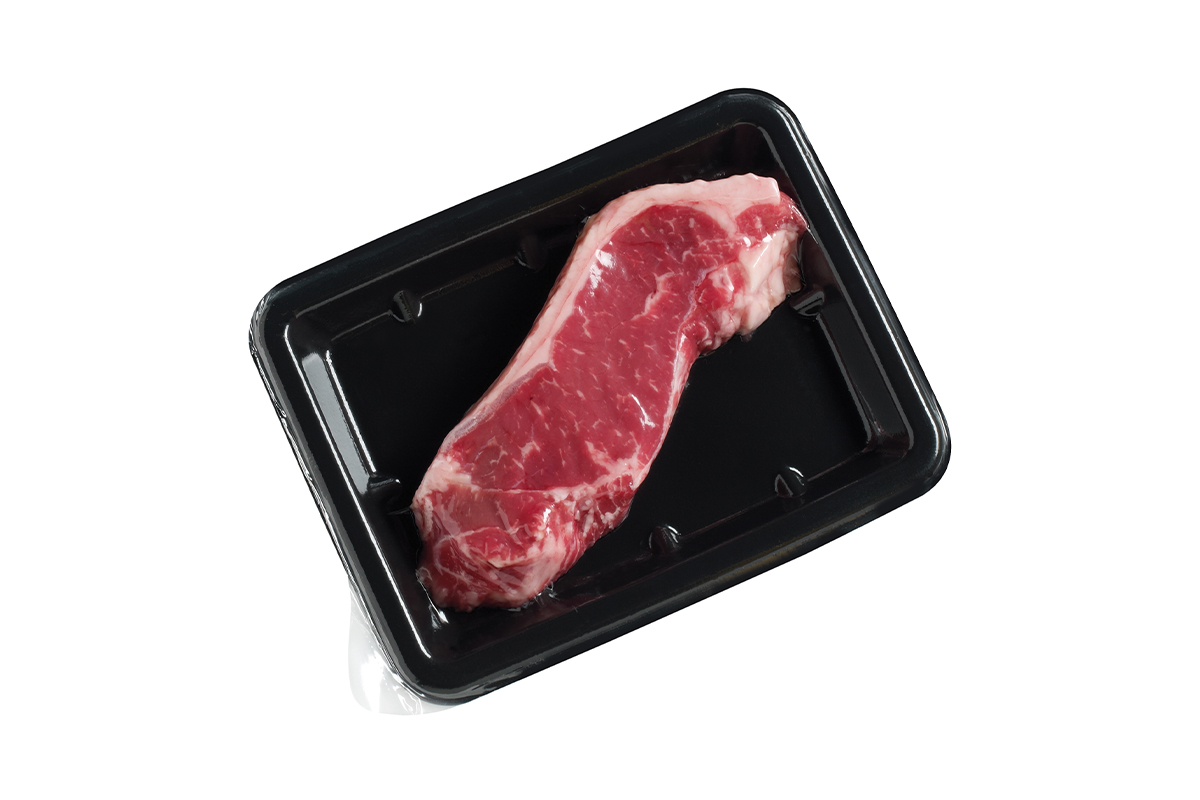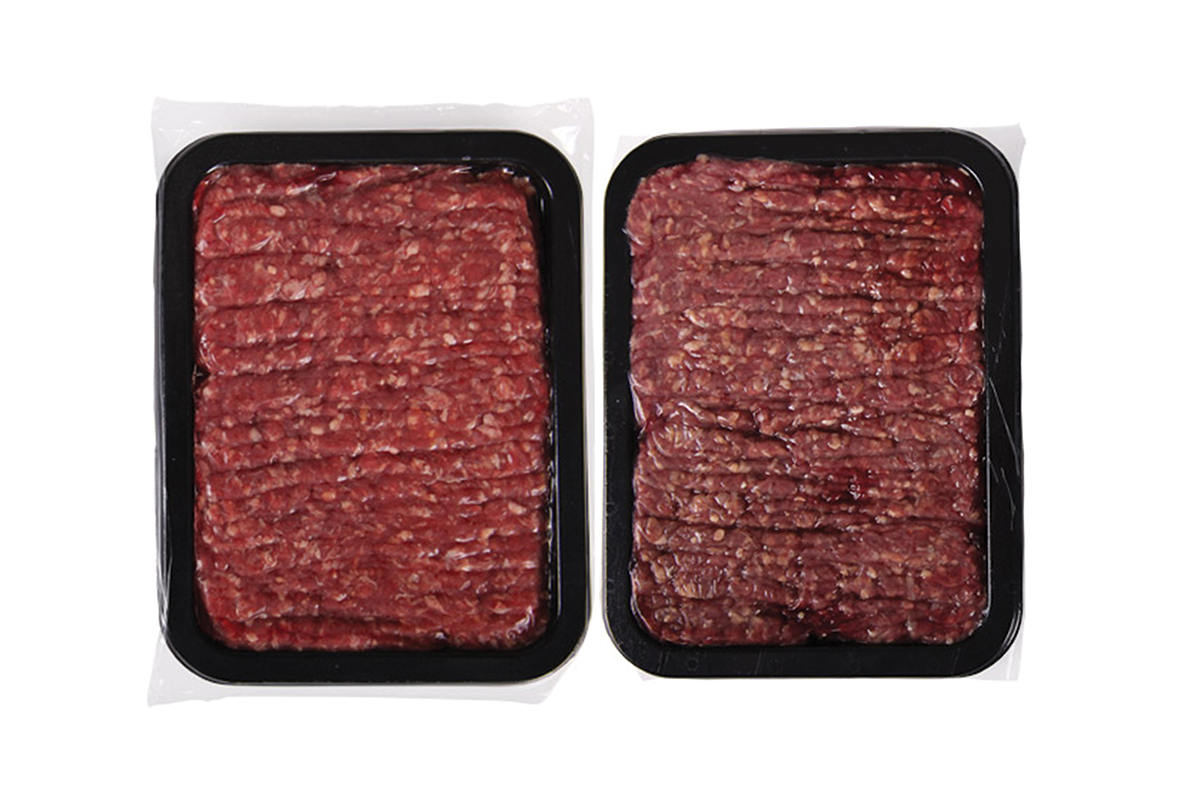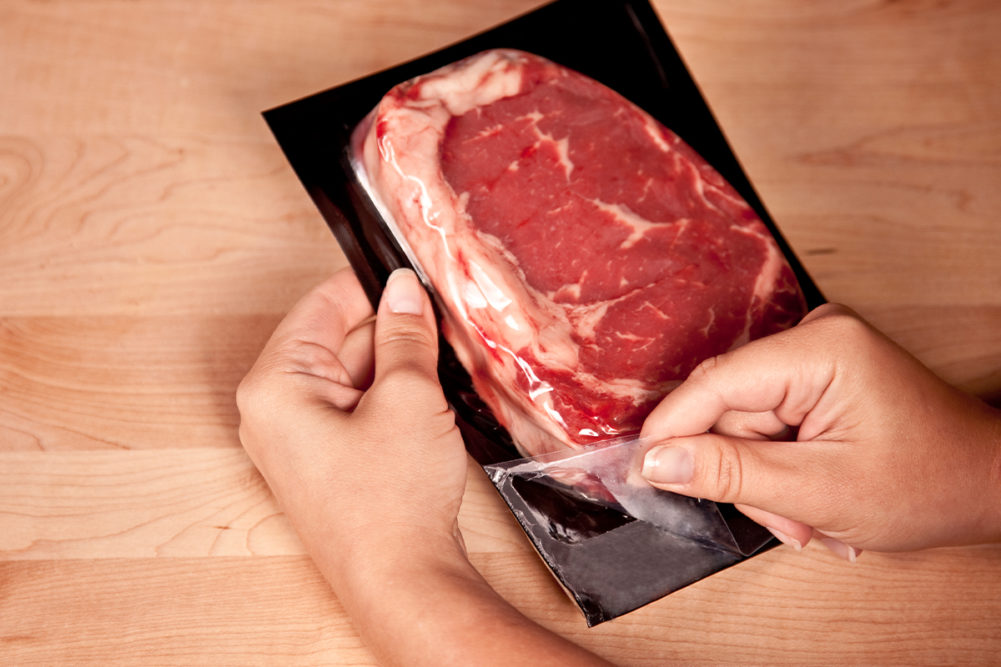Prior to 2000, retailers mostly received large primals or cuts of meat from suppliers in shrink bags or polyethylene bags on ice. Butchers would cut the meat in stores and place it in a case on ice, or package it and put it in a refrigerated case. Retailers would commonly use an EPS foam tray with a PVC stretch overwrap for the meat in the refrigerated case. This style of case packaging tended to have a higher incidence of leaking, as well as being non barrier and limiting shelf life, which often resulted in reduced pricing and food waste.
Today’s processors use high-barrier case-ready trays at the plant and move the responsibility of high-quality packaging away from the retailer, while giving them flexible solutions for retail store and e-commerce shoppers. Benefits to modern case-ready packaging include reduced in-store labor at retail, decreased risk for cross-contamination, reduced retail shrinkage markdowns, sustainability in the form of recyclability and extended shelf life.
On Trend
According to a report titled “2020 Packaging Trends: Ahead of the Recycling Curve” from global market research and insight company Mintel, quality remains the most important standard customers look for when purchasing meat. Sixty-nine percent of shoppers agree that paying more for high-quality products is worth it.
High-barrier packaging, particularly vacuum and skin packaged formats, extends shelf life and ensures consumers optimum freshness and safety when buying and consuming meat and poultry products. In addition, those formats add the benefit of protecting frozen meats from freezer burn.
“We believe we’ll continue to see an expansion of high-barrier case-ready packaging as it provides more versatility to the market,” said Melanie Bandari, senior manager of marketing for Oshkosh, Wis.-based Amcor Flexibles, North America. “Packaging for quality will remain at the forefront of innovation going forward.”
She added, “The pre-packaged formats lend an all-around better consumer experience with aesthetically attractive bright red meat using Amcor FreshCase vacuum packaging technology. FreshCase provides leak-proof transport, ease of opening, and the potential to link products to the consumer experience using graphics and digital scan codes not associated with back of store packaging.”
Processors not only prefer to give consumers what they want but also have their own preferences when it comes to packaging the products they provide. Bandari said Amcor’s customers prioritize and ask for packaging solutions that include longer shelf life, optimal sustainability, excellent on-shelf appearance, production efficiency and unique graphics on the package to stand out on the shelf and tell a story.
Chicken packaged in barrier packaging increases shelf life the same as beef, pork and turkey; however, it sometimes results in a sulfuric odor buildup. Even though the product is safe and consumable, the odor can be off-putting to consumers.
“In response, Amcor has developed an active forming/non-forming film that combines barrier and antimicrobial technologies,” Bandari said. “The barrier provides extended shelf life, while the antimicrobial controls off-putting odors. This solution is a drop-in with existing form-fill-seal lines and is available with our proprietary EZ Peel technology.”
Turkey, beef and pork do not have the same issues as chicken with high barrier. But consumers sometimes balk at beef that’s been barrier vacuum packaged. Although it does provide a hermetic seal and extend shelf life, it can cause fresh beef to appear purple in color. Amcor FreshCase packaging will also combat the color change in beef and maintain a red color under vacuum.
“This provides the best of both worlds: extended shelf life and bright red color,” Bandari said. “It’s a no-compromise solution for shelf life and is a drop-in on existing form-fill-seal equipment. This format has grown in popularity, especially in premium products such as organic meats and high-end steaks.”
 Among many benefits, FreshCase packaging combats beef's color change under vacuum. (Source: Amcor Flexibles North America)
Among many benefits, FreshCase packaging combats beef's color change under vacuum. (Source: Amcor Flexibles North America)
Material world
Case-ready packaging has continued to grow over the years versus foam tray overwrap. According to Chicago-based market research company IRI, case-ready formats have increased from 17% in 2016 to 26% in 2021, and vacuum packaging has overtaken foam overwrap in almost all proteins.
“Case-ready offers many advantages to foam trays including leak resistance, longer shelf life, reliability, reduced freezer burn, high quality appearance and less mess to open,” Bandari said. “In general, the materials, thickness and dimensions — as well as the advantages and disadvantages — vary widely depending on the application the packaging is used for.”
Case-ready packaging materials provide a canvas for processors and marketing departments to use for various graphics and digital technologies that appeal to consumers. Producers have a place to tell the origin stories of their animals and the products that come from those animals. There is also the ability for any and all involved with the final product to offer transparency concerning sustainability directly on the package facing the consumer from the shelf.
“Amcor’s broad portfolio of case-ready packaging spans from flow wrap, forming and lamination film, and trays in a variety of materials, shapes, sizes, colors, thicknesses and run sizes,” Bandari said.
Amcor estimates its newly launched case-ready, easy open flow wrap with an absorbent pad for ground beef offers an average 60% reduction in packaging costs. Using its own asset lifecycle assessment tool certified by the Carbon Trust, the new flow wrap also offers a 70% reduction in carbon footprint from current packaging formats.
“This solution is a more cost-effective, sustainable packaging format, eliminating the foam trays and PVC overwrap with a simple dispense solution,” Bandari added.
Amcor used the Carbon Trust certified tool on another new product, a master bag and flow wrap film offering with the lowest thickness in the industry, according to Bandari, with the same performance as the thicker products. Amcor’s asset lifecycle assessment tool showed the new master bag had the potential to decrease carbon footprint by 40% through the reduction of plastic used compared to the competitive master bag and flow wrap case-ready structure.
“It can withstand high abuse in distribution and is high barrier to extend shelf life of case-ready foam trays with PVC overwrap,” Bandari said of the new master bag.
Another option for the master bag and flow wrap from Amcor is the more sustainable, recycle-ready version that is prequalified for How2Recycle store drop off.
“Because master bags stay behind the counter in retail and do not have contact with meat, the master bags can easily be recycled at the retailer in the store drop off polyethylene stream,” Bandari said.
 Amcor's FreshCase packaging (left), compared to traditional vacuum packaging. (Source: Amcor Flexibles North America)
Amcor's FreshCase packaging (left), compared to traditional vacuum packaging. (Source: Amcor Flexibles North America)
Case-ready to come
Bandari and Amcor believe point-of-sale packaging will continue to influence consumer decision making and differentiation will be a key factor moving forward, as will sustainability and shelf life.
Other factors packaging providers should focus on in the future include convenience and freezer ready products. Amcor has seen strong adoption in both its CPET ovenable trays and Ovenrite ovenable flexible films.
“This technology has built-in self-venting features that open when the product reaches a certain temperature, ensuring product consistency,” Bandari said.
She added, regarding future freezer ready options, “As we saw during COVID, many consumers stockpiled product. Combining differentiation with freezer readiness is another value that consumers will come to expect.” 



